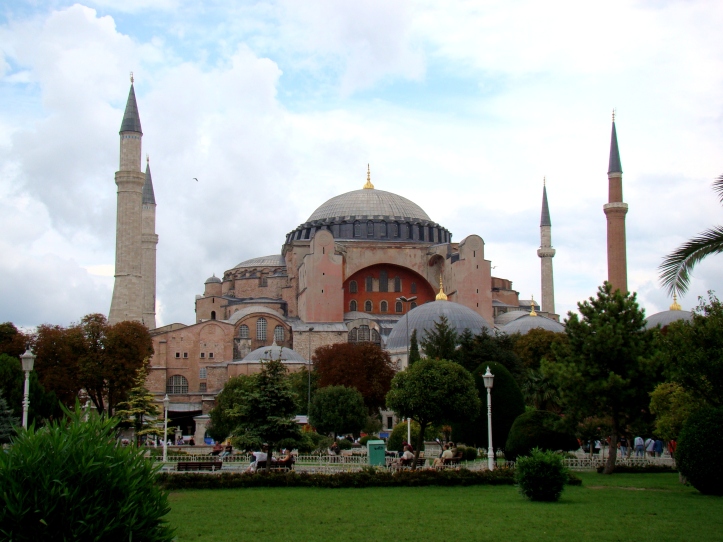
If you ever get to visit Istanbul you have to make a point of exploring Hagia Sofia, the church-turned-mosque. Not only is it unique in this aspect it is also one of the greatest surviving examples of Byzantine architecture in Turkey. It is one of those places you will have to visit more than once as it is so overwhelming that you cant take everything in during your first visit.
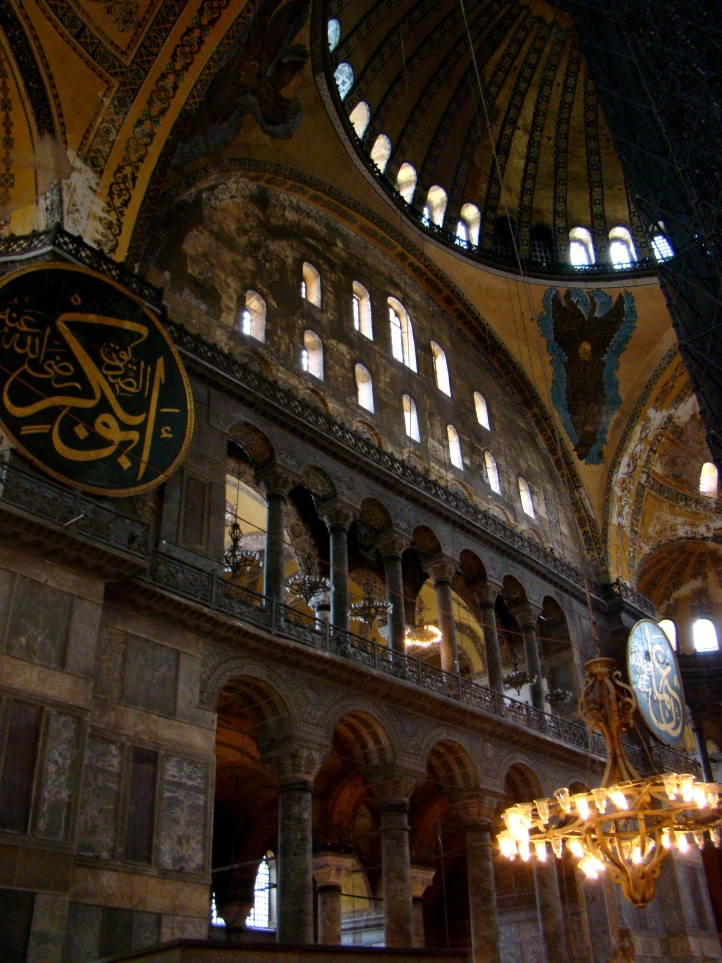
Although scaffolding cluttered a part of the interior the thrill of experiencing the extraordinary spaciousness of this famous church-turned-mosque-turned museum is hard to overstate. As I walked in I was greeted by the marble pillars and huge decorated domes.
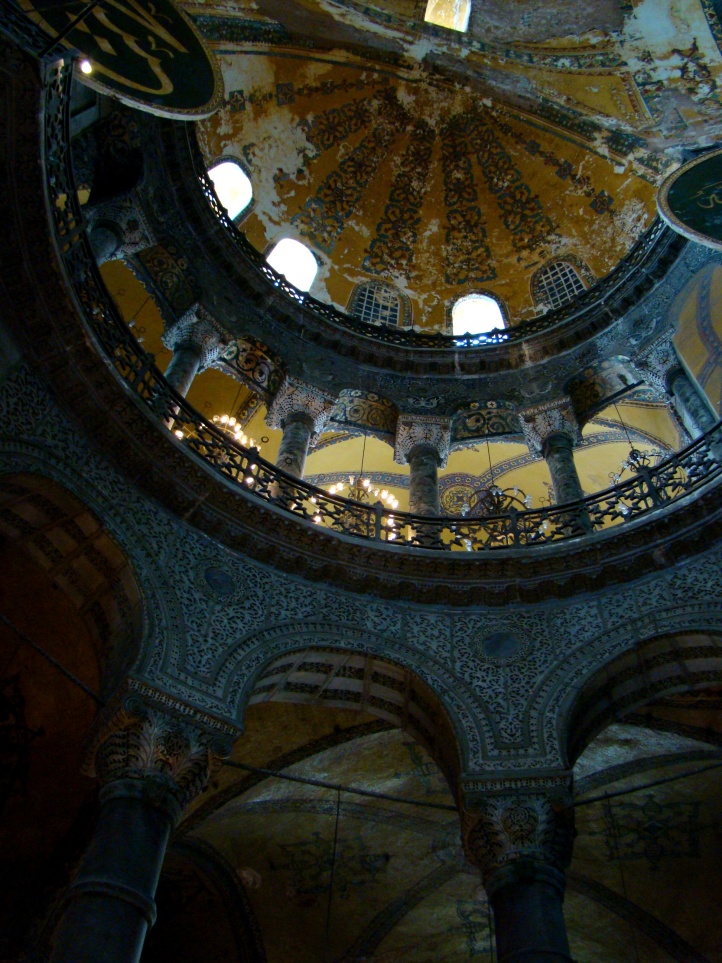
The central dome (which was unfortunately filled with scaffolding) has a diameter of 31 m, which is just slightly smaller than that of the Pantheon in Rome. The dome looks like it is floating upon four great arches which are decorated with seraphim or six-winged angels and other decorative mosaics.

I read that Hagia Sophia is famous for the light that reflects everywhere in the interior of the nave, as its is very bright inside without the need for electric lights. This effect was achieved by inserting forty windows around the base of the original structure.
Most of the interior surfaces are covered with marble, even the floor that you walk on. It is a lovely contrast against the walls which are green and yellow with gold mosaics. Huge parts of Hagia Sophia is decorated in a purely decorative geometric pattern mosaics.
The huge Islamic calligraphic roundels suspended from the main dome also make for a fascinating religious contrast with the uncovered Christian mosaics on the upper part of Hagia Sophia. These gigantic circular-framed disks or medallions are inscribed with the names of Allah, the Prophet Muhammad, and the two grandchildren of Mohammed: Hassan and Hussain.
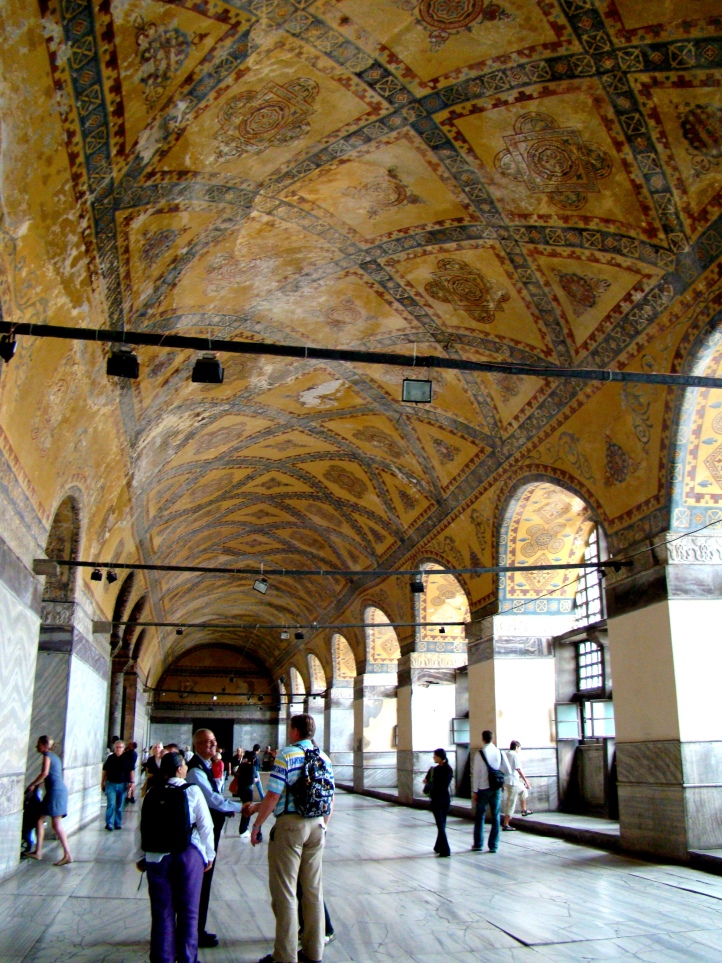
As I walked through Hagia Sophia I could see that most of the sights date from the Islamic period. A beautiful marble structure in the apse is the mihrab, a niche found in all mosques that indicates the direction of Mecca
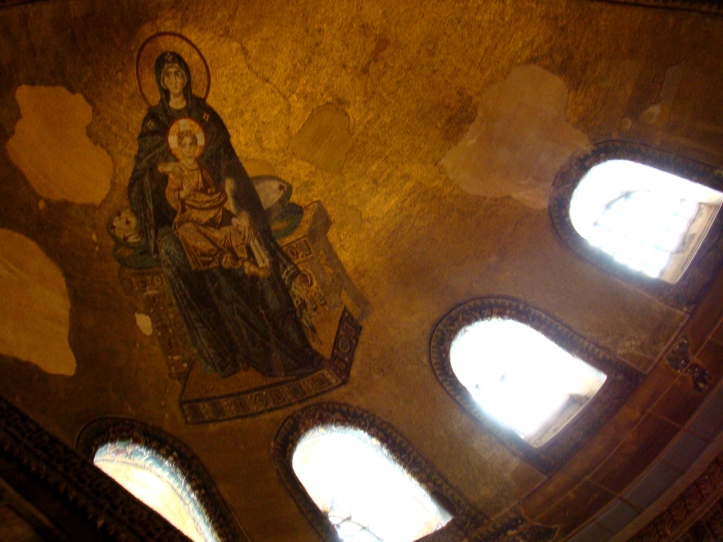
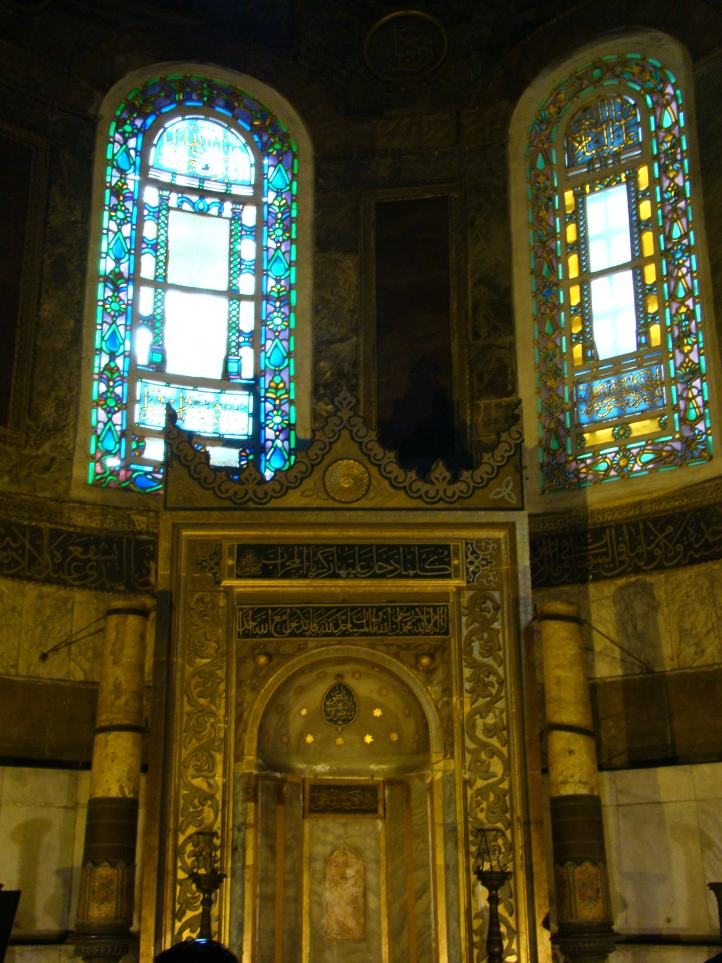
I just love these beautiful pendant chandeliers that fill the huge interior. Although they are hardly needed for light during the day as light seeps through the countless windows.
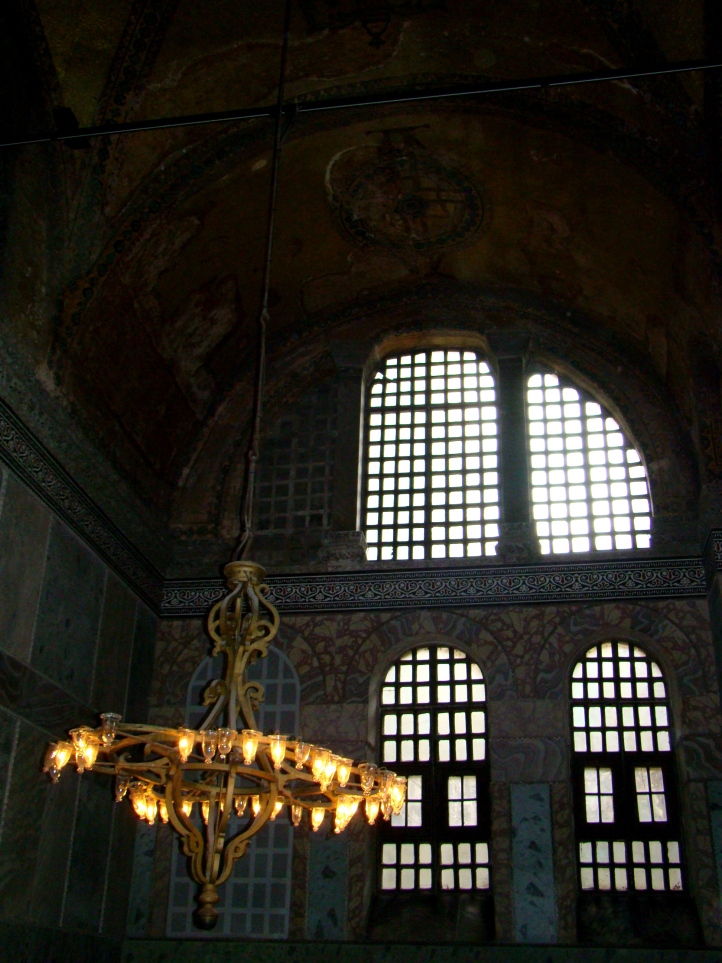
The gallery of this magnificent place provides a commanding view of the nave from all sides. It definitely gives the best vantage point from which to view and experience the vastness of this church-mosque.
The Byzantine mosaics are being gradually uncovered, but only those on the higher gallery levels, which can be accessed by stairways. This means that Muslims do not have to confront much Christian imagery in the main chamber of the building, which was a mosque for nearly 500 years and retains all the equipment of a mosque. Unfortunately this part of the gallery was closed due to restoration that day.
Because of its long history as both a church and a mosque, a particular challenge arises in the restoration process. Christian iconographic mosaics can be uncovered, but often at the expense of important and historic Islamic art. Restorers have attempted to maintain a balance between both Christian and Islamic cultures. In particular, much controversy rests upon whether the Islamic calligraphy on the dome of the cathedral should be removed, in order to permit the underlying mosaic of Christ as Master of the World, to be exhibited (assuming the mosaic still exists).
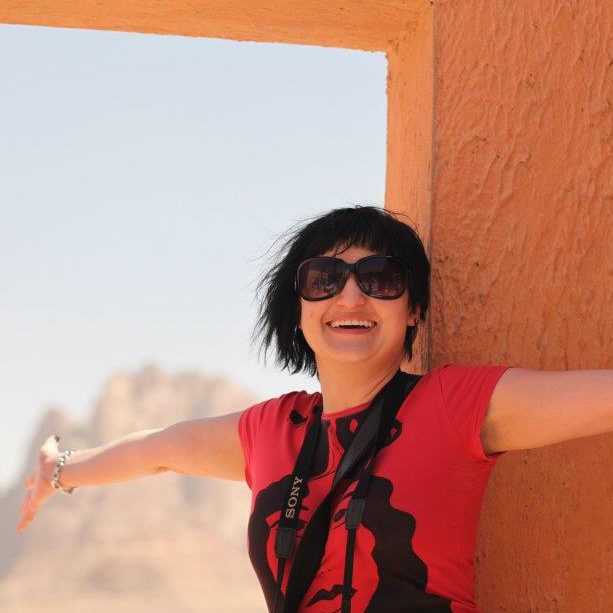
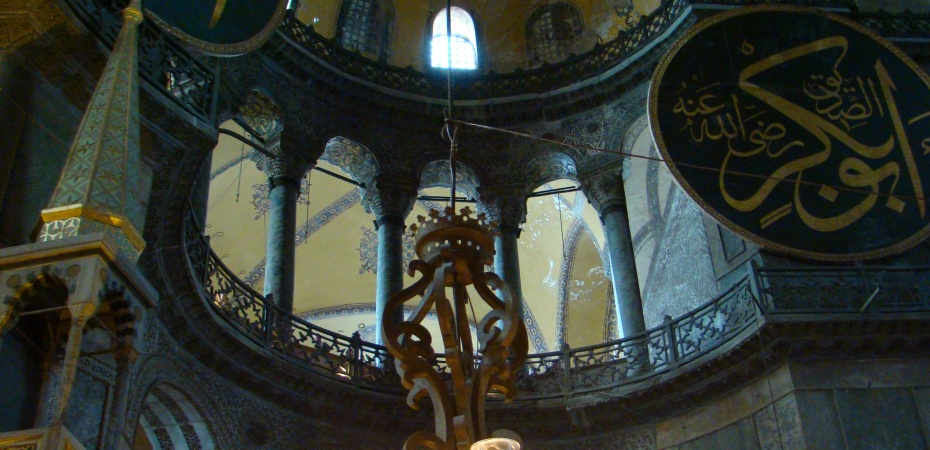















[…] beautiful Hagia Sophia, Turkeys’ Church-turned-Mosque served as the principal mosque of Istanbul, then […]
LikeLike
The “roundlets” you describe are actually the names of the first Caliphs and companions of Mohammad. They read Allah, Mohammad, Omar, Uthman, Abu Bakr, and Ali.
LikeLike
And Hossein and Hassan- Ali’s sons
LikeLike
Excellent interior photos! Well done! I’d love to hear and see what else you came across in Istanbul…Cheers, Tiare
LikeLike
Thanks Tiare! I am busy sorting through my photos and typing up all my Turkish adventures!
LikeLike
Wow, look at that great architecture! Wonderful photos of what undoubtedly is a great place to visit!
LikeLike
Thanks Christy!! While I was there it felt like I was constantly taking photos and now it feels like I didn’t even capture half of the beauty of this place.
LikeLike
Amazing history. It is unfortunate that the restoration process will be a political and religious issue. I can see why one would want to spend more than a brief visit.
LikeLike
I would love to go back again as I am sure that I missed half of it as it is so overwhelming.
LikeLike
Wonderful photos in a challenging lighting environment. I loved my visit to Hagia Sophia and marveled at all the innovations that were embedded int the building like the little squares of glass that predicted earthquakes. It was so interesting to see how the different religions used this beautiful building.
LikeLiked by 1 person
I definitely missed the little squares of glass that predict earthquakes. But I am sure I missed a lot as there is so much to take in that you cant do it all in one visit.
LikeLike
one of the most amazing buildings on Earth! Thanks for sharing!
LikeLike
I completely agree! It should be on everyone’s to-see list!
LikeLike
Your photos and words really brings this beautiful building to life for us who haven’t seen it ourselves Janaline!
I’ve always found it such a beautiful, exotic name; “Hagia Sophia”. Do you have any idea what it means?
LikeLike
Hagia Sophia is from the Greek: Ἁγία Σοφία, meaning “Holy Wisdom. I think it is such a beautiful name for this building.
LikeLiked by 1 person
Absolutely Janaline, thank you!
LikeLike
It is a fantastic site, isn’t it! Did you find the Viking graffiti? I only found it during my second visit!
LikeLike
Oh no, I didn’t know there was any viking graffiti. I will have to go back and look for it!
LikeLiked by 1 person
What an amazing place!! I’ve yet to visit turkey : )) great post! Thanks
LikeLike
I do hope you get to explore Turkey soon as it is such a beautiful country!
LikeLike
Fantastic! I’m so glad I don’t have to make those tough decisions about what to “restore” and what to not! Both what’s visible and what may lie beneath are priceless…
LikeLike
I agree, you don’t want to lose either of them but to restore the one you lose the other which is quite sad.
LikeLike
I guess all of us have heard of Hagia Sophia if we took geography or world history. But now I finally get to see the inside. Beautiful!
LikeLiked by 1 person
It was such an amazing experience, being inside this building that I have heard so much about. And it was even better than I had imagined it would be.
LikeLike
Wow… what an incredible work of art!
Very informative post, Janaline and the images are really beautiful.
Thanks a lot for sharing 🙂
LikeLike
Thanks Sreejith! Istanbul is an amazing place filled with so many beautiful buildings!
LikeLike
This is so gorgeous. I am a member of a Masonic Order called the Red Cross of Constantine. My Conclave is Hagia Sophia 🙂
LikeLike
Ah that is excellent!!
LikeLike
Oh, marvellous – this is a place I intend to see…..
LikeLike
I hope you get to see it very soon Sue, it is marvelous!
LikeLike
wonderful – and my older son has always wanted to visit the Hagia Sophia after studying it in high school – great post! ❤
LikeLike
Thank you! I do hope he gets to visit it someday as it is such a treasure to explore. Not only is it beautiful but it is also so rich in history and controversy.
LikeLike